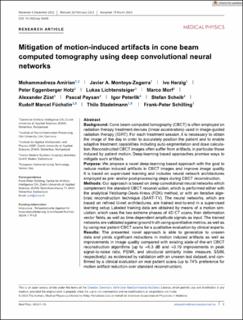Please use this identifier to cite or link to this item:
https://doi.org/10.21256/zhaw-27603| Publication type: | Article in scientific journal |
| Type of review: | Peer review (publication) |
| Title: | Mitigation of motion-induced artifacts in cone beam computed tomography using deep convolutional neural networks |
| Authors: | Amirian, Mohammadreza Montoya-Zegarra, Javier A. Herzig, Ivo Eggenberger Hotz, Peter Lichtensteiger, Lukas Morf, Marco Züst, Alexander Paysan, Pascal Peterlik, Igor Scheib, Stefan Füchslin, Rudolf Marcel Stadelmann, Thilo Schilling, Frank-Peter |
| et. al: | No |
| DOI: | 10.1002/mp.16405 10.21256/zhaw-27603 |
| Published in: | Medical Physics |
| Volume(Issue): | 50 |
| Issue: | 10 |
| Page(s): | 6228 |
| Pages to: | 6242 |
| Issue Date: | 30-Mar-2023 |
| Publisher / Ed. Institution: | Wiley |
| ISSN: | 0094-2405 2473-4209 |
| Language: | English |
| Subjects: | CBCT; Deep learning; Motion artifact |
| Subject (DDC): | 006: Special computer methods 616: Internal medicine and diseases |
| Abstract: | Background: Cone beam computed tomography (CBCT) is often employed on radiation therapy treatment devices (linear accelerators) used in image-guided radiation therapy (IGRT). For each treatment session, it is necessary to obtain the image of the day in order to accurately position the patient, and to enable adaptive treatment capabilities including auto-segmentation and dose calculation. Reconstructed CBCT images often suffer from artifacts, in particular those induced by patient motion. Deep-learning based approaches promise ways to mitigate such artifacts. Purpose: We propose a novel deep-learning based approach with the goal to reduce motion induced artifacts in CBCT images and improve image quality. It is based on supervised learning and includes neural network architectures employed as pre- and/or post-processing steps during CBCT reconstruction. Methods: Our approach is based on deep convolutional neural networks which complement the standard CBCT reconstruction, which is performed either with the analytical Feldkamp-Davis-Kress (FDK) method, or with an iterative algebraic reconstruction technique (SART-TV). The neural networks, which are based on refined U-net architectures, are trained end-to-end in a supervised learning setup. Labeled training data are obtained by means of a motion simulation, which uses the two extreme phases of 4D CT scans, their deformation vector fields, as well as time-dependent amplitude signals as input. The trained networks are validated against ground truth using quantitative metrics, as well as by using real patient CBCT scans for a qualitative evaluation by clinical experts. Results: The presented novel approach is able to generalize to unseen data and yields significant reductions in motion induced artifacts as well as improvements in image quality compared with existing state-of-the-art CBCT reconstruction algorithms (up to +6.3 dB and +0.19 improvements in peak signal-to-noise ratio, PSNR, and structural similarity index measure, SSIM, respectively), as evidenced by validation with an unseen test dataset, and confirmed by a clincal evaluation on real patient scans (up to 74% preference for motion artifact reduction over standard reconstruction). Conclusions: For the first time, it is demonstrated, also by means of clinical evaluation, that inserting deep neural networks as pre- and post-processing plugins in the existing 3D CBCT reconstruction and trained end-to-end yield significant improvements in image quality and reduction of motion artifacts. |
| URI: | https://digitalcollection.zhaw.ch/handle/11475/27603 |
| Fulltext version: | Published version |
| License (according to publishing contract): | CC BY-NC-ND 4.0: Attribution - Non commercial - No derivatives 4.0 International |
| Departement: | School of Engineering |
| Organisational Unit: | Centre for Artificial Intelligence (CAI) Institute of Applied Mathematics and Physics (IAMP) |
| Published as part of the ZHAW project: | DIR3CT: Deep Image Reconstruction through X-Ray Projection-based 3D Learning of Computed Tomography Volumes |
| Appears in collections: | Publikationen School of Engineering |
Files in This Item:
| File | Description | Size | Format | |
|---|---|---|---|---|
| 2023_Amirian-etal_Mitigation-of-motion‐induced-artifacts-cone-beam-computed-tomography.pdf | 4.42 MB | Adobe PDF |  View/Open |
Show full item record
Amirian, M., Montoya-Zegarra, J. A., Herzig, I., Eggenberger Hotz, P., Lichtensteiger, L., Morf, M., Züst, A., Paysan, P., Peterlik, I., Scheib, S., Füchslin, R. M., Stadelmann, T., & Schilling, F.-P. (2023). Mitigation of motion-induced artifacts in cone beam computed tomography using deep convolutional neural networks. Medical Physics, 50(10), 6228–6242. https://doi.org/10.1002/mp.16405
Amirian, M. et al. (2023) ‘Mitigation of motion-induced artifacts in cone beam computed tomography using deep convolutional neural networks’, Medical Physics, 50(10), pp. 6228–6242. Available at: https://doi.org/10.1002/mp.16405.
M. Amirian et al., “Mitigation of motion-induced artifacts in cone beam computed tomography using deep convolutional neural networks,” Medical Physics, vol. 50, no. 10, pp. 6228–6242, Mar. 2023, doi: 10.1002/mp.16405.
AMIRIAN, Mohammadreza, Javier A. MONTOYA-ZEGARRA, Ivo HERZIG, Peter EGGENBERGER HOTZ, Lukas LICHTENSTEIGER, Marco MORF, Alexander ZÜST, Pascal PAYSAN, Igor PETERLIK, Stefan SCHEIB, Rudolf Marcel FÜCHSLIN, Thilo STADELMANN und Frank-Peter SCHILLING, 2023. Mitigation of motion-induced artifacts in cone beam computed tomography using deep convolutional neural networks. Medical Physics. 30 März 2023. Bd. 50, Nr. 10, S. 6228–6242. DOI 10.1002/mp.16405
Amirian, Mohammadreza, Javier A. Montoya-Zegarra, Ivo Herzig, Peter Eggenberger Hotz, Lukas Lichtensteiger, Marco Morf, Alexander Züst, et al. 2023. “Mitigation of Motion-Induced Artifacts in Cone Beam Computed Tomography Using Deep Convolutional Neural Networks.” Medical Physics 50 (10): 6228–42. https://doi.org/10.1002/mp.16405.
Amirian, Mohammadreza, et al. “Mitigation of Motion-Induced Artifacts in Cone Beam Computed Tomography Using Deep Convolutional Neural Networks.” Medical Physics, vol. 50, no. 10, Mar. 2023, pp. 6228–42, https://doi.org/10.1002/mp.16405.
Items in DSpace are protected by copyright, with all rights reserved, unless otherwise indicated.